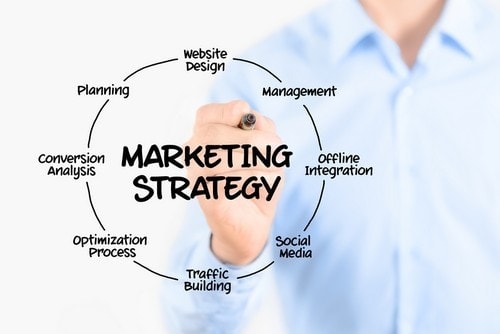What Are the Key Elements of a Successful Marketing Strategy?
A well-designed marketing strategy is essential for any business aiming to grow, build a brand, and connect with customers. In today’s fast-paced, highly competitive market, businesses must be able to adapt quickly and make data-driven decisions that maximize their marketing efforts. Whether you’re a small startup or an established company, a robust marketing strategy can help guide your efforts, optimize your resources, and achieve measurable results.
But what exactly goes into a successful marketing strategy? In this article, we will break down the key elements of an effective marketing strategy and how you can implement them for your business.
1. Clear Business Goals and Objectives
Before creating any marketing strategy, it’s important to first define your business goals and objectives. A marketing strategy should align with and support your overall business plan. Without a clear vision, your marketing efforts will lack direction and focus.
Key Steps:
- Define SMART Goals: SMART goals are Specific, Measurable, Achievable, Relevant, and Time-bound. For example, “Increase online sales by 20% within the next six months.”
- Short-Term vs Long-Term Goals: Your strategy should account for both immediate and long-term objectives, from raising brand awareness to establishing customer loyalty.
- Align with Business Growth: Your marketing efforts should help the company move toward its larger goals, whether it’s expanding into new markets, increasing revenue, or launching new products.
2. In-Depth Market Research
Market research is the foundation of any successful marketing strategy. Understanding your audience, competition, and market trends enables you to make informed decisions that resonate with your target demographic.
Key Steps:
- Know Your Target Audience: Define who your ideal customers are, including their demographics, psychographics, preferences, pain points, and buying behaviors. This allows you to tailor your marketing messages and campaigns to meet their needs.
- Competitive Analysis: Analyze what your competitors are doing, what’s working for them, and where they might be falling short. This helps you identify opportunities and differentiate your brand.
- Industry Trends: Stay up-to-date on industry changes, technological advancements, and shifts in consumer behavior. This knowledge helps you stay competitive and adjust your strategy as needed.
3. Unique Value Proposition (UVP)
Your Unique Value Proposition (UVP) is what sets you apart from your competitors. It’s the reason customers should choose your brand over others. A strong UVP communicates the benefits and value of your product or service in a way that resonates with your target audience.
Key Steps:
- Clearly Define What Makes You Different: Identify the aspects of your product, service, or brand that set you apart from competitors. Is it your quality, price, customer service, or unique features?
- Communicate Benefits, Not Just Features: Make sure your UVP focuses on how your product or service benefits the customer, not just its features. For instance, instead of saying, “Our product is fast,” you could say, “Our product helps you save time and increase productivity.”
- Consistency: Your UVP should be consistently communicated across all marketing channels, from social media to your website, so customers can instantly recognize what makes your brand special.
4. Brand Positioning
Brand positioning refers to how you want your brand to be perceived in the minds of your customers relative to competitors. It’s about carving out a unique space in the market and establishing a strong, distinct identity.
Key Steps:
- Identify Your Brand’s Core Values: These values should resonate with your target audience and guide all of your messaging, visual identity, and customer interactions.
- Create a Consistent Brand Voice and Visual Identity: From your logo and color scheme to your tone of voice, everything should align with your brand’s personality. This helps build trust and recognition.
- Communicate the Benefits: Your positioning should focus on how your brand solves problems and delivers value to your customers in ways that competitors cannot.
5. Integrated Marketing Channels
A successful marketing strategy leverages multiple channels to reach your target audience. With the rise of digital marketing, there are more ways than ever to connect with customers, but it’s important to choose the right channels based on your target market.
Key Channels to Consider:
- Social Media Marketing: Platforms like Facebook, Instagram, Twitter, and LinkedIn allow you to engage with your audience, build brand awareness, and drive traffic to your website. Choose platforms that align with where your audience spends their time.
- Content Marketing: Offering valuable and relevant content (blogs, videos, podcasts, etc.) helps you establish authority in your industry, build trust, and attract leads.
- Email Marketing: Email campaigns help nurture leads, retain customers, and deliver personalized messages directly to your audience’s inbox.
- Paid Advertising: Google Ads, Facebook Ads, and display ads can increase visibility and drive traffic quickly. This is particularly useful for targeting specific customer demographics.
- SEO (Search Engine Optimization): Optimizing your website and content for search engines ensures that customers can find you when they search for relevant terms.
6. Actionable Tactics and Plans
Once you have identified your goals, audience, and channels, the next step is to develop actionable tactics. This is where you break down the strategy into concrete, executable steps. This could include setting up campaigns, creating content, or running promotions.
Key Steps:
- Create Campaigns and Content Plans: Develop content that speaks to your audience’s pain points, interests, and needs. Plan campaigns around holidays, product launches, or industry events.
- Set Specific Milestones and KPIs: Milestones help you measure progress, and KPIs (Key Performance Indicators) like conversion rates, click-through rates, and return on investment (ROI) allow you to track the success of your campaigns.
- Budgeting and Resources: Assign appropriate resources and allocate budgets to each channel or tactic based on its priority and expected ROI. This ensures that your marketing efforts remain within budget and are scalable.
7. Effective Customer Relationship Management (CRM)
Building and nurturing strong customer relationships is an essential part of any successful marketing strategy. Loyal customers can become your best advocates, and good customer relationships increase lifetime value (LTV).
Key Steps:
- Engagement: Respond to customer inquiries and comments promptly, especially on social media and customer support channels. Engaged customers feel valued and more likely to return.
- Personalization: Use customer data to send personalized offers and messages that are tailored to their preferences and behaviors.
- Loyalty Programs: Consider creating loyalty programs that reward repeat customers and incentivize referrals. This fosters a deeper connection and encourages continued purchases.
8. Continuous Monitoring and Adaptation
A good marketing strategy is dynamic and adaptable. What works today might not be effective tomorrow, and it’s crucial to monitor your performance and adjust your approach based on real-time data.
Key Steps:
- Track Metrics: Use analytics tools like Google Analytics, social media insights, and email campaign reports to track performance. Keep an eye on metrics like traffic, conversions, bounce rates, and customer acquisition costs.
- A/B Testing: Regularly test different messages, designs, and tactics to see which versions resonate the most with your audience.
- Optimize for Results: If something isn’t working, don’t be afraid to pivot. Whether it’s adjusting your messaging, trying new marketing channels, or shifting your focus, optimization is key to sustained success.
9. Budget Allocation and ROI
A successful marketing strategy also requires careful budget planning. Without sufficient resources, your marketing efforts may fall short of their potential. It’s essential to allocate the budget according to your goals and anticipated ROI.
Key Steps:
- Define Your Marketing Budget: Determine how much you’re willing to spend on marketing efforts based on the goals you’ve set. Consider the cost of paid ads, content creation, social media management, and any external tools or agencies.
- Allocate Funds Wisely: Spend the majority of your budget on the channels that deliver the best return on investment. If a particular tactic is generating leads or sales, consider increasing the budget for that channel.
- Measure ROI: Use ROI metrics to gauge whether your marketing spend is bringing in more revenue than it costs. If ROI isn’t meeting expectations, adjust your strategy accordingly.
Conclusion
A successful marketing strategy isn’t a one-size-fits-all approach — it’s about understanding your audience, setting clear goals, leveraging the right channels, and continuously optimizing your efforts. By focusing on the key elements of market research, brand positioning, customer engagement, and adaptability, businesses can create a comprehensive marketing strategy that drives growth, builds brand loyalty, and ultimately leads to long-term success. Whether you’re starting fresh or revisiting your current marketing plan, incorporating these fundamental elements will help you navigate the competitive landscape and achieve your desired outcomes.

